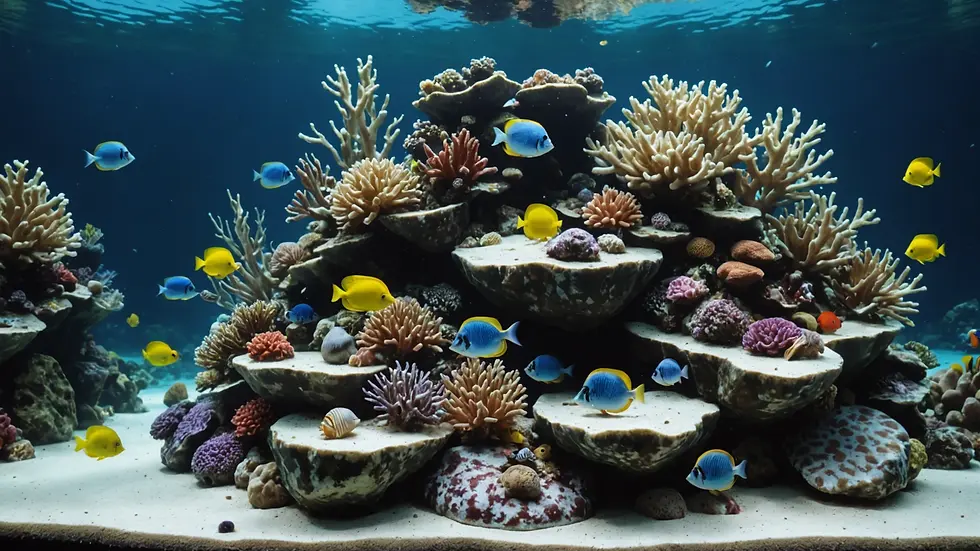How Can I Start a Thriving Saltwater Aquarium in 5 Simple Steps?
- Jyotiraj Borah
- Feb 6
- 4 min read
Establishing a saltwater aquarium can be one of the most rewarding hobbies. Picture a dynamic underwater landscape full of vibrant fish and beautiful corals right in your home. Although it may seem intimidating at first, getting started doesn't have to be complicated. This guide will break down the process into five simple steps, helping you set up a successful saltwater aquarium without stress.
Step 1: Choose the Right Aquarium Size
Choosing the right aquarium size is a critical first step. While smaller tanks may initially appear more manageable, larger tanks typically provide a more stable ecosystem. Here's how to decide:
*Available Space: Determine the weight capacity and dimensions of the area where you will place the aquarium. A 50-gallon tank weighs about 500 pounds when full, while a 20-gallon tank is about 230 pounds. Make sure your floor can support it.
*Fish Variety: Different species have specific space needs. For example, a small clownfish requires a minimum of 20 gallons to thrive, while a large angelfish would need at least 75 gallons. Research the species you wish to keep before committing.
*Time and Commitment: Larger tanks require more time for maintenance, yet they can support a greater variety of marine life. For beginners, a 30-gallon tank offers a good balance of space and manageability.
Remember to measure your designated space thoroughly before settling on a size.

Step 2: Gather Essential Equipment
Having the right equipment is key to creating a thriving saltwater aquarium. Quality products can make a significant difference in your aquarium's health. Here’s what you need to set up your tank:
*Aquarium: Select the size you determined earlier.
*Filtration System: Invest in a high-quality filtration system. Canister filters or protein skimmers are good options to keep water clean.
*Heater: Most marine species thrive between 76°F and 82°F, so choose a heater capable of maintaining this temperature range.
*Lighting: If you plan on having live plants or corals, LED lighting is energy-efficient and supports healthy growth.
*Substrate: Opt for sand specifically designed for saltwater tanks, typically 1-2 inches deep.
*Live Rock: Adding 1 to 2 pounds of live rock per gallon of water enhances filtration and provides hiding spots.
*Testing Kits: Ensure you have kits for testing pH, ammonia, nitrite, nitrate, and salinity. Regular tests help prevent dangerous conditions.
While purchasing quality equipment may require careful consideration and possibly a higher upfront cost, it is a worthwhile investment for the long-term success of your aquarium.
Step 3: Prepare the Aquarium
An adequate setup is vital for your aquarium's longevity and the well-being of your marine life. Here’s how to prepare your tank:
Wash the Tank: Rinse it thoroughly with fresh water, avoiding any soaps or chemicals that could harm your fish.
Install the Substrate: Rinse before pouring 1-2 inches of live sand or substrate into the tank.
Add Live Rock: Create an aesthetically pleasing and functional arrangement, providing both hiding spots and support for corals.
Fill the Tank: Slowly add pre-mixed saltwater or fresh water treated with a water conditioner to remove harmful elements.
Setup Equipment: Install and test your filtration system, heater, and lighting according to the manufacturer’s guidelines.
Cycle the Tank: Allow 4 to 6 weeks for your tank to cycle. During this period, beneficial bacteria will establish, converting toxic ammonia into safer compounds.
Patience is key during this phase. Cycling is essential for a stable saltwater environment.

Step 4: Choose and Introduce Marine Life
Now comes the exciting part: adding fish and marine creatures to your aquarium. Here are some tips to ensure a smooth introduction:
*Research Species: Select species that are compatible. Hardy choices such as clownfish and damsels are excellent for beginners and adapt well.
*Start Slowly: Add new fish gradually—ideally no more than two to three at a time—to minimize stress on your system.
*Acclimate the Fish: Use the drip method to slowly acclimate new fish. This involves placing them in their transport bag in the tank for 15-30 minutes, then adding small amounts of tank water over 1-2 hours before releasing them.
*Consider Invertebrates: If you plan to keep invertebrates, ensure your water conditions are appropriate for their specific needs, usually requiring a dedicated reef setup.
Make sure to monitor the new additions closely for any signs of stress or illness. Adding marine life transforms your aquarium into a lively ecosystem.
Step 5: Maintenance and Care
Consistent maintenance is crucial for the health and beauty of your saltwater aquarium. Here are some ongoing tasks to develop a routine around:
*Water Testing: Check the water parameters weekly. Ideal ranges include ammonia below 0.25 ppm, nitrite at 0 ppm, nitrate below 20 ppm, and pH between 8.1 and 8.4.
*Water Changes: Replace about 10-15% of the water each week to maintain optimal conditions. This can significantly improve overall water quality and fish health.
*Cleaning: Regularly wipe away algae from the glass and substrate. Utilize special tools like algae scrapers but avoid scrubbing too hard, which can damage beneficial bacteria.
*Observe Your Aquarium: Take note of your fish's behavior. Any signs of distress may require immediate attention.
*Feeding: Offer a balanced diet suited to the variety of species in your aquarium. Be mindful of feeding amounts to prevent water quality issues.
Maintaining a thriving saltwater aquarium takes commitment and regular care. However, the vibrant environment and the joy it brings make every effort worthwhile.
Final Thoughts
Creating a beautiful saltwater aquarium is a journey filled with learning, patience, and satisfaction. By following these five steps—choosing the right size, gathering essential equipment, preparing your tank, introducing marine life, and conducting regular maintenance—you can experience the joy and tranquility of a thriving underwater ecosystem.
As you embark on your aquarist adventure, remember: every great aquarium starts with a commitment to your fish's health and happiness. Enjoy the process of building your underwater oasis!





Comments